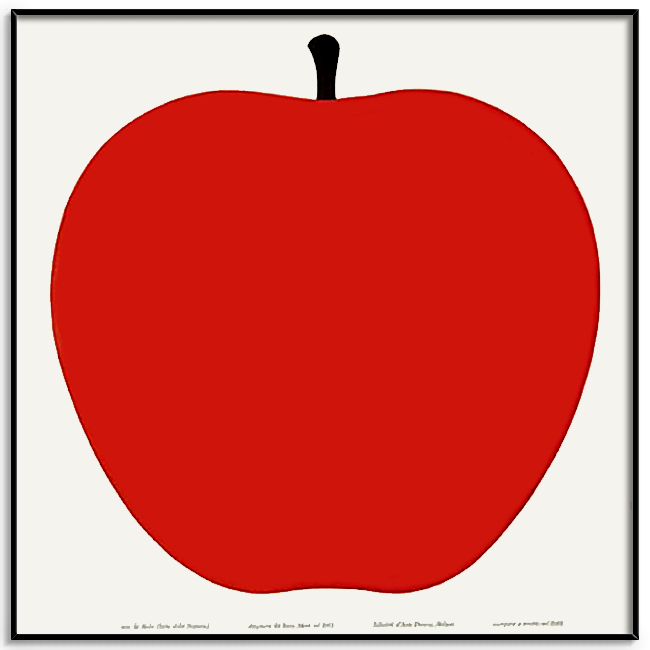Enzo Mari spent the year 1957 drawing an apple. The result, La Mela, is a large silkscreen print [↓] produced as an artist multiple by Danese Milano continuously since.

Mari had the apple up in his studio [↓] for a year, considering and adjusting its form — trying to get the curve just right.

He lavished time on the drawing, preparing it for manufacture by abolishing detail and reducing it to an essential form. He was not looking to draw *an* apple, but rather *the* apple — a perfect symbol designed for the serial logic of industrial reproduction. In place of the unique work of art and its privileged market, multiples used contemporary manufacturing to produce many exact copies circulated as consumer products. The Apple was only the first in a series (Serie della Natura) of similar prints Mari designed over the next ten years.
Curator and Enzo Mari archivist Francesca Giacomelli, describes his departure point for the series in the catalog for a recent comprehensive exhibition at The Triennale in Milan. He wanted a subject that was easily understood, and started from Caravaggio’s Basket of Fruit, a painting he thought everyone could recognize [↓]:

He continued with pictures of animals, vegetables, and other fruits, For each, Mari would start

Mari had the apple up in his studio [↓] for a year, considering and adjusting its form — trying to get the curve just right.

He lavished time on the drawing, preparing it for manufacture by abolishing detail and reducing it to an essential form. He was not looking to draw *an* apple, but rather *the* apple — a perfect symbol designed for the serial logic of industrial reproduction. In place of the unique work of art and its privileged market, multiples used contemporary manufacturing to produce many exact copies circulated as consumer products. The Apple was only the first in a series (Serie della Natura) of similar prints Mari designed over the next ten years.
Curator and Enzo Mari archivist Francesca Giacomelli, describes his departure point for the series in the catalog for a recent comprehensive exhibition at The Triennale in Milan. He wanted a subject that was easily understood, and started from Caravaggio’s Basket of Fruit, a painting he thought everyone could recognize [↓]:

He continued with pictures of animals, vegetables, and other fruits, For each, Mari would start
a long process of research aimed at the simplification of form via the creation of hundreds of models of which he studied each and every detail (for the goose, for instance, he studied the eye, the beak, even the nostrils, etc.)He applied this research process to each image, since (now, Mari speaking):
quality does not reside in the grouping together of many elements but in the absolute perfection of only one element.In a recent interview, Mari outlined the process. Describing his approach to research more broadly in his work, Mari offered this succinct theorem:
The research is the design, not the product.Continues in class . . .
March 4, 2024
Not *an* apple, but *the* apple
Readings
Investigation Into Perceptive Ambiguities (Francesca Giacomelli)
Resources
Enzo Mari website
The Enzo Mari Method (1968)
Enzo Mari curated by Hans Ulrich Obrist with Francesca Giacomelli
A Method Arising from the Initial Research Into the Perceptive Ambiguity of Three-Dimensional Space
Interview
Assignment
Research, Reconsider, Repeat (check-in #1)
Not *an* apple, but *the* apple
Readings
Investigation Into Perceptive Ambiguities (Francesca Giacomelli)
Resources
Enzo Mari website
The Enzo Mari Method (1968)
Enzo Mari curated by Hans Ulrich Obrist with Francesca Giacomelli
A Method Arising from the Initial Research Into the Perceptive Ambiguity of Three-Dimensional Space
Interview
Assignment
Research, Reconsider, Repeat (check-in #1)